Hello all 🙂
Following the advice of a fellow forumer, I seek advice over some issue I have with certain sp. in my first tank 60L Lowtech.
3 " easy " species and an unidentified specimen are having issues in my tank. Which is weird since some plant categorize as "moderate" or even "hard" do really well like Pogostemon helferi and Rotala walichii which are growing like crazy.
Hardware
26 Watt cheap Led Light from Amazon ( not RGB )
400L/h internal filter directed a little bit against the backwall to reduce the flow in the tank
A 100W heater set to 25°C
Stocking
a female Betta
6 Amano shrimp
3 Nerite snails
2 Neocarina shrimp
Water parameter
1/5 really hard tap water with 4/5 DI water from the supermarket to which I had 2ppm of Magnesium.
It gets me to around 25ppm CA / 5ppm Mg / kH=3
I dose macro and micro on alternate day for a total a week of :
17ppm NO3
1,7ppm PO4
24ppm K
Easy life Profito equivalent to 0,16ppm Fe
+ I add 1ppm of Mg mid-week
Now the issue :
Hygrophila coymbosa, Althernanthera lilacina and the unidentified plant are getting pinholes on the older leaf which are then shredded even more by the Amano and they melt at the base of the stem. And they are getting green dust algae on the older leaf too.
Eleocharis parvula, planted a little more than a month ago, as stopped melting but doesn't grow at all.
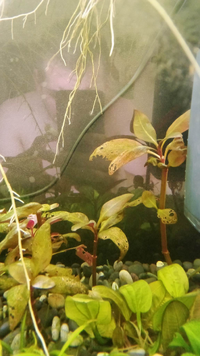
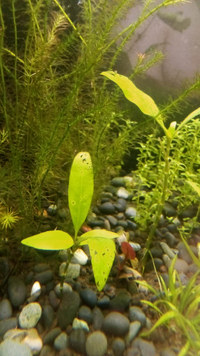
And the unknown species that you could maybe help me identify.
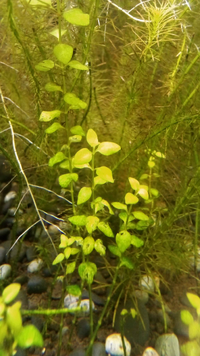
For those using the Duckweed Index, I want to had that i have a lot of emersed and floating plant growing which show no sign of deficiency.
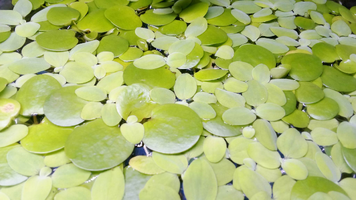
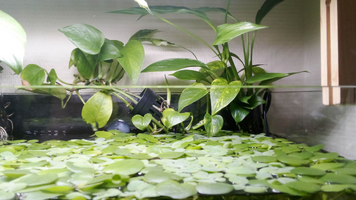
I know pinhole sometimes mean K deficiency but since I'm dosing near EI level and my floating plant don't show anything i don't think it's the case.
I'm maybe gonna add a little bit more PO4 and micro in the future since they are on the low side compare to the other nutrient.
But I would lean more toward a CO2 deficiency issue but those plants are suppose to do well without CO2 and they are not the most ill-placed in term of flow.
I can't augment the flow due to my betta really not liking it. So I've let the floating plant cover all the surface over those plant to reduce the CO2 demand but it did not have much positive result . They now die faster than they grow but the algae has receded a little.
I'm really perplexed like i'm blasting the full light over the Rotala Wallichii which is supposed to need CO2 without any problem (except a bit of hair algae ) but the Hygrophila, which is supposed to be one of the easiest genus in the hobby is dying.
Thanks in advance for the response. 🙂

Following the advice of a fellow forumer, I seek advice over some issue I have with certain sp. in my first tank 60L Lowtech.
3 " easy " species and an unidentified specimen are having issues in my tank. Which is weird since some plant categorize as "moderate" or even "hard" do really well like Pogostemon helferi and Rotala walichii which are growing like crazy.
Hardware
26 Watt cheap Led Light from Amazon ( not RGB )
400L/h internal filter directed a little bit against the backwall to reduce the flow in the tank
A 100W heater set to 25°C
Stocking
a female Betta
6 Amano shrimp
3 Nerite snails
2 Neocarina shrimp
Water parameter
1/5 really hard tap water with 4/5 DI water from the supermarket to which I had 2ppm of Magnesium.
It gets me to around 25ppm CA / 5ppm Mg / kH=3
I dose macro and micro on alternate day for a total a week of :
17ppm NO3
1,7ppm PO4
24ppm K
Easy life Profito equivalent to 0,16ppm Fe
+ I add 1ppm of Mg mid-week
Now the issue :
Hygrophila coymbosa, Althernanthera lilacina and the unidentified plant are getting pinholes on the older leaf which are then shredded even more by the Amano and they melt at the base of the stem. And they are getting green dust algae on the older leaf too.
Eleocharis parvula, planted a little more than a month ago, as stopped melting but doesn't grow at all.


And the unknown species that you could maybe help me identify.

For those using the Duckweed Index, I want to had that i have a lot of emersed and floating plant growing which show no sign of deficiency.


I know pinhole sometimes mean K deficiency but since I'm dosing near EI level and my floating plant don't show anything i don't think it's the case.
I'm maybe gonna add a little bit more PO4 and micro in the future since they are on the low side compare to the other nutrient.
But I would lean more toward a CO2 deficiency issue but those plants are suppose to do well without CO2 and they are not the most ill-placed in term of flow.
I can't augment the flow due to my betta really not liking it. So I've let the floating plant cover all the surface over those plant to reduce the CO2 demand but it did not have much positive result . They now die faster than they grow but the algae has receded a little.
I'm really perplexed like i'm blasting the full light over the Rotala Wallichii which is supposed to need CO2 without any problem (except a bit of hair algae ) but the Hygrophila, which is supposed to be one of the easiest genus in the hobby is dying.
Thanks in advance for the response. 🙂




